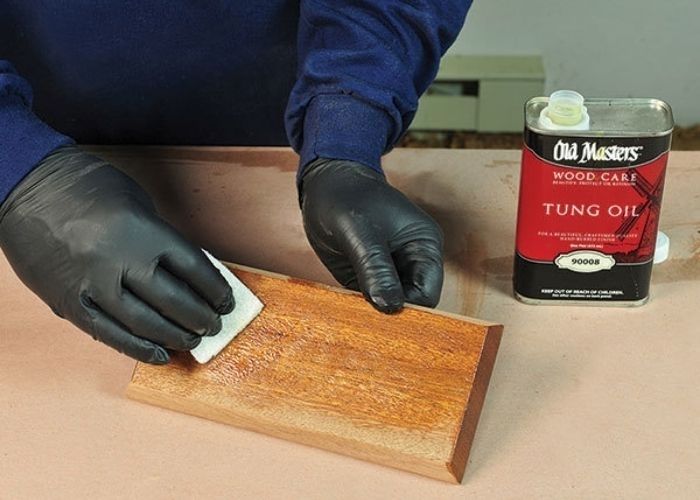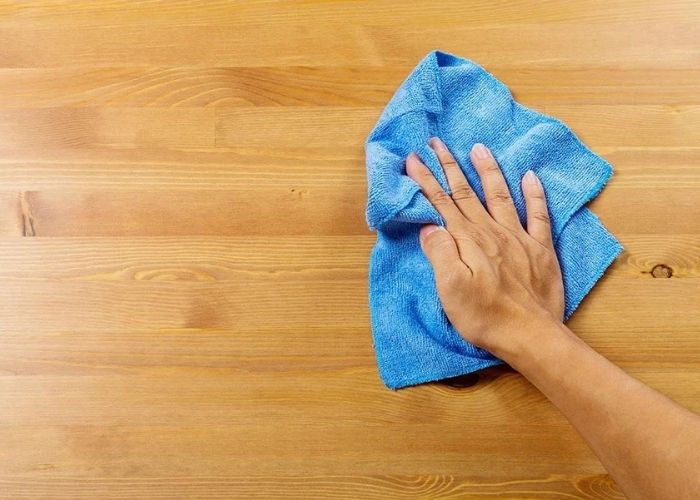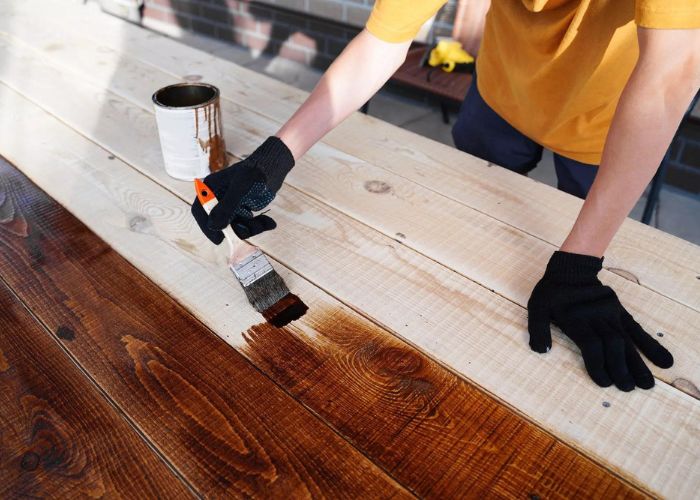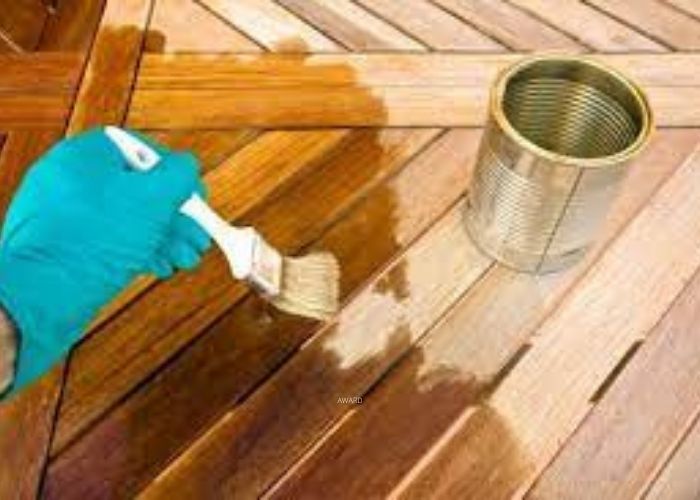Can you put Tung oil over stain? Well, the possibility may sound too good to be true, almost impractical. But is it?
Tung oil and stain are penetrative products applied to wood mainly to protect it against external damage and aesthetics on the side. You can apply them on finished and unfinished wood.
Find out the practical details about using both products on wooden surfaces and expert tips to help you get the job done right in one go.
Can You Put Tung Oil over Stain?
Yes, you can. Once the stain is fully dry, continue layering the surface using Tung oil. Whether you’re using pure Tung oil or the modified versions, apply light coats at a time. Wait for it to dry and harden, scuff sand and then reapply subsequent coats.
Can You Apply Tung Oil over Oil-Based Wood Stain?
Absolutely! Tung oil blends well with oil-based finishes. Of course, layering is only possible once the oil-based stain is dry. However, Tung oil doesn’t apply over surfaces finished with varnishes –you’d have to strip the varnish before using the oil.

Can You Apply Tung Oil over Water-Based Stain?
Yes, you can. Oil finishes over a water-based stain add a layer of protection. Regardless of the type of water-based stain used –Water-soluble dye stain or premixed –ensure it is fully dry before coating it with Tung oil.
How to Apply Tung Oil over Stained Wood
There’s a practical way to navigate this process, and I will guide you step by step.
This wood finish oil will help you achieve a durable and exceptional hand-rubbed finish on your surfaces. After that, the maintenance is a walk in the park.
What you will need:
- Respirator face mask
- Rubber gloves
- Plastic sheeting
- Dusting cloth
- Soft polishing cloth
- Lint-free cloth
- Stain Applicator pad
- Stain and Tung oil
- Fine grit sandpaper
The steps for applying Tung oil over stain
Step 1: Prepare your workstation and wear protective gear
Start by ensuring the working space is adequately ventilated. Next, line the floor and other areas of the space with plastic sheeting to catch any spills. Finally, wear your gloves and a respirator mask.
Step 2: Sand and clean the stained surface

If you’re working on new wood, thoroughly sand the surface along the grain to even out any imperfections. Clean up the sanding dust using a tack cloth, then begin applying the stain.
However, if you’re working on a recently stained surface, regardless of the stain, you still need to scuff sand the surface, so Tung oil has a base to attach.
But if the stained surface is fairly old, countersink any protruding nails or screws and then fill up gaps using wood filler. Afterward, sand down any bumps, dents, or splinters. Finish sanding using fine-grit sandpaper and then clean up the dust.
You might wonder, “Is wood filler strong enough to screw into?” Well, it’s usually better to screw into solid wood rather than relying solely on wood filler.
If a large spot is left bare after sanding and repairs, especially for fairly old surfaces or external structures, you can apply one or two coats of stain before Tung oil.
Step 3: Prepare the oil finish
Stir the oil well and pour a bit into a bowl or container.
Pure Tung oil has a honey-like thick consistency. You can use it as it is or thin it with mineral spirits or turpentine. Use a 1:1 oil to thinner ratio. Alternatively, you can opt for fast-drying Tung oil blends.
Step 4: Apply the first coat of Tung oil

The same way you apply polyurethane over minwax tung oil finish is the same way you are going to apply the tung oil. Dip your lint-free cloth in the oil and rub it on the stained surface. You can use a stain brush if you’re coating a large surface.
Apply the oil evenly along the wood grain until the surface is saturated. If the stained surface was recently completed, wait at least 12 hours before applying the Tung oil topcoat.
Step 5: Wait for the first coat to dry
Wait for 15 minutes to allow the oil to seep into the surface and then wipe off the excess product using a clean, lint-free cloth. Pure Tung oil dry time ranges between 24-72 hours, while modified Tung oil blends need about an hour or two to dry.
Step 6: Apply the next coat
Lightly sand it using super-fine grit sandpaper once the surface is dry to the touch. Alternatively, you can buff it using ultra-fine steel wool. Finally, tack the dust and then reapply the following oil coats.
Step 7: Repeat steps 5 and 6 until you’re satisfied
You will need to apply 3-4 layers of the oil for a completely waterproof, more durable surface.
Step 8: Buff the finished surface
Buff the finished surface using a soft polishing cloth to bring out the sheen. Of course, only buff after the project has sufficient dry time.
Tung Oil on Stained Wood: Maintaining Tung Oil Finishes
Tung oil finishes provide a beautiful, moisture-resistant finish that isn’t prone to cracking caused by seasonal weather changes. That said, maintaining Tung oil finishes on stained wood is easy.
- Place rugs or floor mats on heavy foot traffic areas of the wood floor finished with Tung oil.
- As soon as you notice minor scratches on the surface, sand it smooth, and then add a fresh coat of Tung oil finish.
- Recoat indoor wood surfaces every 2-4 years. For outdoor surfaces, you can recoat them after a year or two, depending on the wood species used and the degree of damage from exposure to elements such as sunlight, rain, and snow.
If it comes to it, here’s our guide on removing tung oil from wood.
FAQs
How to apply Tung oil finish over wood stain
- Prepare your workstation and wear protective gear.
- Clean and sand the stained surface.
- Prepare the oil finish.
- Apply the first coat of tung oil.
- Wait for the first coat to dry.
- Apply the next coat.
- Repeat steps 5 and 6 until you’re satisfied.
- Buff the finished surface.
Can I put Tung oil over MinWax stain?
Yes, you can. Ensure the stain is completely dry before coating it with a Tung oil finish. Then, rub it on the surface using a clean cloth, wipe off the excess and let it air dry fully before recoating it.
Will Tung oil darken stain?
No, it won’t. Tung oil has an amber tone and will only add a warm luster to the stained wood. It also doesn’t darken with age or exposure to elements. Therefore, your finished surfaces will retain the same tone over the years. Read more to answer the question “Can tung oil make wood darker?”
Does Tung oil remove stains?
No. Quite the contrary, Tung oil hardens and keeps the stain in place. In addition, the oil finish forms an impenetrable seal on the stained wood surface and consequently keeps the wood from damage by water and scratches.
How long should I let the stain dry before applying Tung oil?
The standard waiting time for the stain to dry before Tung oil is 12 hours. Use this timeframe, particularly if you applied an oil-based wood stain. Water-based stain is ready for tung oil once fully dry and isn’t gummy when sanded.
Do you have to sand between coats of Tung oil?
It’s okay to sand between every coat of the oil; if not, to remove any imperfections, determine if the surface is dry enough for recoating. In which case, use fine-grit sandpaper (400-600) or ultra-fine steel wool.
How many coats of Tung oil should be applied?
For a dense wood or an already stained surface, a minimum of four coats will suffice. However, for a new wood or a porous surface, you can apply up to 7 coats.
Can you put Formby Tung oil finish over stain?
No. Formby recommends against using Tung oil over stained surfaces or other finishes that aren’t naturally penetrating oils.
Is Tung oil finish food safe?
Yes, Tung oil finish is food-safe once it has fully cured. When Tung oil cures, it forms a hard and protective finish that is resistant to water and most common household chemicals. This finish is safe for surfaces that come into contact with food, such as wooden cutting boards, countertops, and wooden utensils.
Read More: How to Mix Stains for Wood
What’s Next?
So, can you put tung oil over stain? Absolutely! Tung oil doesn’t interfere with the stain; instead, it bonds well and guarantees a more durable, waterproof finish.
Whether the stained surface is fresh or a bit aged, scuff sand it and then rub in Tung oil. You can use Pure Tung oil or Tung oil blends; it’s up to you.
Engage us in the comments section below if you have concerns about layering Tung oil over other finishes. Also, take a moment to explore our informative article on tung oil vs poly.

